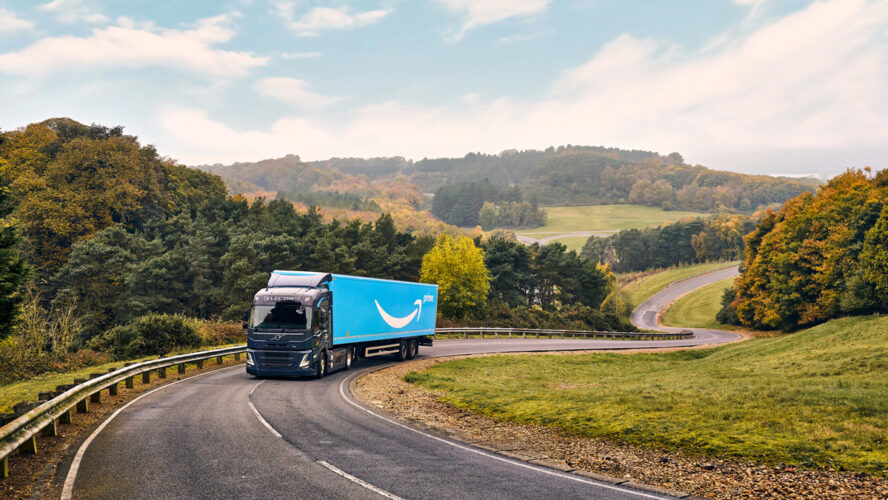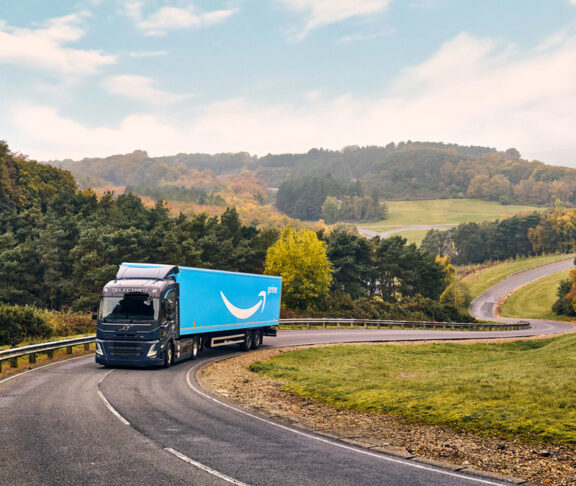
Chris Roe
Managing Director, Amazon Freight EU
Logistics is carbon-intensive. Yet, one business is making its operations more sustainable with an ambitious net-zero target and the use of experimentation and innovation.
Chris Roe, Managing Director of Amazon Freight EU, outlines a chart with five key areas of company strategy. “One of these is sustainability. It’s there very deliberately so that every time I’m speaking to my team or the stakeholders we work with, everyone understands that sustainability is part of our future.”
Logistics meets sustainability challenges
Of course, sustainability is a particular challenge for the logistics industry. “Ever since commerce was invented, humans have developed increasingly efficient ways of getting things from A to B,” says Roe. “But ‘efficient’ doesn’t necessarily mean ‘best for the environment’.”
Amazon Freight is a comparative newbie in the shipping world. After launching in 2019, it rapidly expanded into new markets with an exclusive focus on middle mile (B2B) road freight delivery for businesses of all sizes, offering full-truckload (FTL) services for goods shipped to any destination. Part of its success comes from its ability to tap into the wider company’s established logistics infrastructure and integrate with its fulfilment and distribution centres.
With this, companies must consider their carbon footprint. “The industry can’t continue to operate in the way it has,” says Roe. “We don’t have an option. We know that burning fossil fuel produces carbon, and we know the impact of carbon on climate. Therefore, we all need to continue in the right direction of reducing our carbon footprint.”
Working towards a 2040 zero-carbon target
Many companies talk a good sustainability game. At some point, though, they have to prove they are taking concrete steps to reduce their carbon footprints. Roe insists that Amazon Freight takes its environmental responsibilities ultra-seriously, noting that in 2022, Amazon unveiled plans to invest over €1 billion in the coming years to further electrify and decarbonise its operations across Europe. Three years on, the company has invested in charging infrastructure across its operations in Europe, now has more than 60 micro-mobility hubs in more than 45 European cities, plans to have more than 10,000 electric delivery vans on the road by year end, and has ordered more than 200 electric heavy goods vehicles, the beginnings of which will also join its fleet by year end.
He also points out that the wider Amazon business has extremely ambitious carbon reduction targets. “The EU is committed to net zero carbon emissions by 2050,” says Roe. “But in 2019, Amazon co-founded the Climate Pledge — a goal to achieve net zero by 2040. We set a goal 10 years ahead of the EU because it’s the direction of travel for the wider business, and it’s a topic our customers care about.”
Nevertheless, he agrees that a target like this can either be viewed as a daunting challenge or an exciting opportunity. Roe opts for the latter. “I see it as a real opportunity for differentiation and being able to innovate in ways that other businesses in our sector haven’t yet thought about,” he says. “That’s why we have to experiment with different sustainability measures.”
If a decision is a two-way door, we’re
happy to walk through it, experiment,
and if we get things wrong, we can
just walk back through the door again
Making increasing use of lower-carbon fuels
When solving a problem, Amazon operates a ‘one-way door’ and a ‘two-way door’ decision-making process, explains Roe. “If a decision is a two-way door, we’re happy to walk through it, experiment, and if we get things wrong, we can just walk back through the door again. It’s reversible. However, if a decision is a one-way door — once we walk through it, the door is locked behind us — we have a very high bar for experimentation. Thankfully, most of the decisions around sustainability are two-way doors, giving us flexibility to test and experiment.”
For instance, Amazon Freight recently announced its largest order of electric heavy goods vehicles (eHGVs), with more than 200 new Mercedes-Benz Trucks eActros 600 vehicles joining its transportation network in Europe. When fully operational, the trucks are estimated to transport more than 350 million packages every year.
“It’s very possible that those vehicles will be outdated sooner than we would like because the technology is moving at such a pace,” says Roe. “But it’s a two-way door because we’re not committing our entire fleet to one particular model. We’re simply buying the next tranche of trucks and leveraging the next level of technology.”
Two-way door process enables experimentation
Apart from increasing use of middle-mile electric vehicles to move shipments between Amazon facilities, the company is also experimenting with a number of lower-carbon fuels, including renewable diesel, green hydrogen and CNG (compressed natural gas); although, presently, no obvious frontrunner has emerged. “Which is why we’re working on a two-way door process to try different technologies, and we’ll see which of them is the best fit for our business,” says Roe.
He also reveals that energy and waste-saving initiatives are in place across the network and that “every single watt of electricity used in our operation is matched with renewable sources. That’s been the case for two years now.”
Maximising efficiencies across existing operations
Not every sustainable measure has to be new and revolutionary. Roe believes the company can achieve big short-term sustainable gains by driving efficiencies through its existing operations. One example of this is better route planning, which can reduce fuel consumption, improve driver efficiency and minimise delays.
Another is freight consolidation, where multiple small shipments, often from separate suppliers, are combined into a single, larger shipment for transportation, helping to solve the problem of low truck fill rates and congested roads.
Utilising and sharing data to reduce carbon
Making consolidation work requires good collaboration, however. The idea is that if businesses from all industries get better at proactively sharing routing and scheduling information with each other, consolidation rates should increase, and carbon emissions should reduce.
Both measures need investment in — and intelligent use of — advanced technology, such as the machine learning-enabled data-driven route planning tech employed by Roe and his team. “I see real possibilities in utilising data,” he says. “Crunching data and finding opportunities to share is going to be the biggest way, short-term, to reduce carbon.”
Flexible packaging with machine learning
Tech is driving sustainability in other important ways at Amazon Freight. For example, machine learning is helping teams work out which products are suitable for flexible packaging, which can significantly reduce the weight of parcels.
Deployed properly, Roe insists that this type of technology can enhance the work that humans do and make their lives easier. “We want our people to keep interacting and doing the things they are good at,” he says. “But technology can be used to superpower them. That’s certainly what we’ve seen with the robotics we use in our fulfilment centres, for instance.”
Continued investment and a long-term commitment
While Roe is optimistic about sustainability in the logistics sector, he’s also under no illusions. Getting Amazon Freight to zero carbon in just 15 years will be tough, he admits. Adopting new technology, shaking up processes and training teams to work in new ways is hard and requires investment and commitment. Yet, quite apart from the environmental imperative, he recognises that a focus on sustainability also makes good business sense in the long term. Plus, he knows what the company is capable of achieving.
“I’ve been at Amazon for 10 years,” he says. “What I see is that when we have a target, we do what we can to hit it. When things happened — like the pandemic — and we needed to change direction, we did it.
“Achieving net-zero is not going to be a linear path, but take battery electric vehicles, for example. When we first invested in them, their range was simply not good enough. However, we’ve continued to invest as the technology has improved and, as I say, we’ve just placed our largest-ever order of electric heavy trucks. So, I see intention translate into action — that gives me confidence.”


